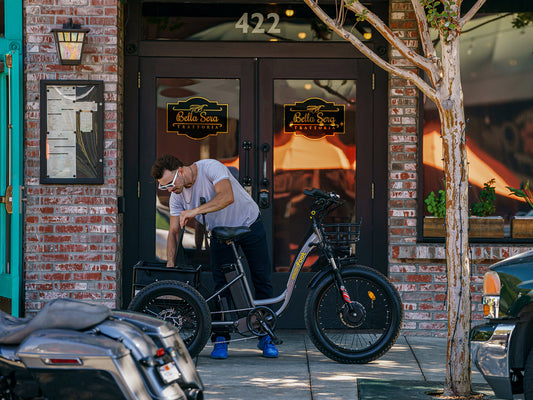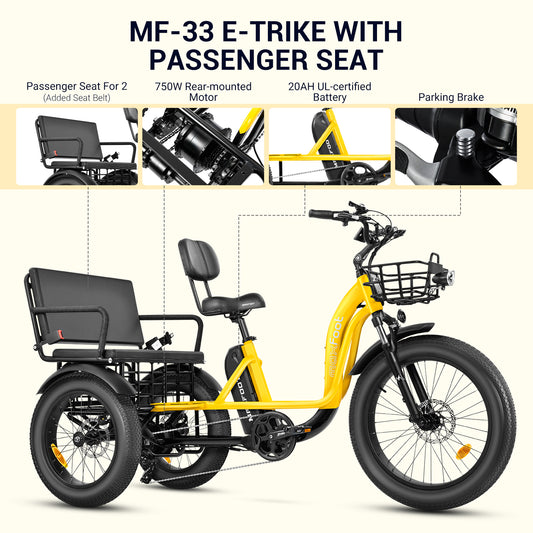Imagine the wind in your hair, the sun on your face, and the intoxicating sense of freedom as you power over rugged terrain, up steep inclines, and through verdant valleys. There's an electrifying charge in the air and it's not just the buzz of adventure - it's the hum of your trusty steed, an electric touring-style bike designed to conquer challenging all-terrain routes.
As you prepare for this journey, a question arises: amidst the sea of options in the market, how do you find that perfect electric bike? The one that effortlessly marries power, comfort, and endurance, designed to thrive where ordinary bikes falter?
Navigating this choice can feel like a challenging route in itself. But you don't have to worry. In this guide, we’ll light the path to help you make the perfect choice. We will be exploring the ins and outs of what makes an all-terrain e-bike stand out from the crowd, helping you discover the ideal ride for your adventure.
Things To Consider When Buying An Electric Touring-Style Bike
Choosing the right all-terrain electric bike (e-bike) is a task that requires careful thought and consideration of various factors. Here are some of the key elements you should check before making your purchase:
How powerful should the motor on your all-terrain touring e-bike be?
Motor power is an important factor to consider. It determines how effectively your e-bike can climb steep hills and traverse challenging terrains. Typically, e-bikes come with motor power ranging from 250W to 1000W.
For all-terrain biking, you might want to opt for higher motor power, something above 500 W would suit you the most. However, keep in mind that more power often means a shorter battery life.
Another debate is on mid-drive vs hub motors. Hub motors, which usually power the rear wheel, are more affordable, lighter, and cheaper. Thus, you’ll find them in most ebikes. However, mid-drive motors offer more balanced power, which is required if you’re planning to move across challenging.
What range should you expect from your e-bike?
The battery size will determine how far and long you can ride your e-bike on a single charge. Look for bikes with high-quality lithium-ion batteries, and consider the total range that the e-bike can cover on a single charge.
In this case, since the goal is touring, an e-bike model with a longer range (probably more than 50 miles per) charge would suffice.
What materials and design elements make for a durable and lightweight e-bike frame?
Durability and weight are crucial considerations when choosing an e-bike for all-terrain use. Look for frames made from high-quality materials which are both strong and lightweight. Commonly touring frames are made from aluminum, Chromoly steel, carbon fiber, and titanium. Aluminum is the lightest and less costly while steel is greatly known for its longevity and resistance to vibrations. Carbon fiber and titanium are also one of the strongest candidates but the price point goes from affordable to premium.
Why is a good suspension system important for all-terrain biking?
Ebikes can have front suspension, rear suspension, or full suspension. The front suspension is usually in the form of a fork with a mechanical coil, on the front wheel. This suspension system usually suits light-driving bikes on the road. The rear suspension comes with an additional shock absorber, which absorbs the shocks and bumps of uneven terrains, providing a smoother ride.
However, an all-terrain e-bike requires a full suspension which is a combination of both. Although this suspension makes the bike ride safe and comfortable, it makes it a little heavy and expensive.
What type of tires or wheels work best for all-terrain e-bikes?
For all-terrain biking, look for e-bikes with thick, sturdy tires that can handle a variety of surfaces. Wide tires with deep treads offer better traction and control on loose or slippery terrain.
Choose 26-inch or 700c wheels as they are commonly available. Their large size allows for covering more ground in a pedal. This makes it an ideal choice for unpaved roads and challenging terrains.
The strength of the wheels is also important. Apart from the material, the best way to gauge its strength is the number of spokes. Choose wheels with at least 32 to 36 spikes. Also, check how many times these spokes cross. Look for a bike wheel in which the spokes cross at least twice.
What type of braking system is most efficient for all-terrain e-bikes?
When it comes to e-bikes, there are two primary types of braking systems: rim brakes and disc brakes. Rim brakes, which are often found on traditional bicycles, work by applying friction to the rim of the bike's wheels. They are cheaper and easily replaceable but they wear out easily and their response time is lower.
Disc brakes, which have become increasingly popular on e-bikes and mountain bikes, function by applying friction to a brake rotor mounted to the wheel hub. There are two types of disc brakes: mechanical (also known as cable-activated or cable-pull) and hydraulic. Disc brakes, either hydraulic or mechanical, provide superior stopping power and perform well in various weather conditions.
When choosing a bike, pay particular attention to the size of the brake discs; a larger disc (180mm or more) provides better heat dissipation and stronger stopping power.
What weight limit should I consider for an all-terrain e-bike?
Check the weight limit of the e-bike, which includes the weight of the rider and any gear or luggage. An all-terrain e-bike should have a high enough weight limit to support your weight along with any equipment you may need for your tour.
Typically, an e-bike that would support 275 to 300 lbs. would be sufficient.
How many levels of pedal assistance should your e-bike offer?
E-bikes generally come with different levels of pedal assistance. For off-road, hilly terrain, an e-bike with at least 5 levels of pedal assist allows you to adjust the level of motor assistance according to the steepness and difficulty of the terrain.
How much should your e-bike ideally weigh?
The weight of an e-bike can affect both its handling and its range. While more robust e-bikes may offer more features and durability, they can be harder to handle and may reduce the range.
Consider an e-bike that weighs close to 60 lbs for an optimal balance of durability and maneuverability.
How important is a high IP rating for your e-bike?
Since all-terrain biking can expose the e-bike to various weather conditions, including rain, look for an e-bike with a high IP (Ingress Protection) rating.
A rating of IP65 or IP67 indicates that the bike is dust-tight and protected against water projected from a nozzle.
Final Thoughts
The perfect all-terrain e-bike is more than a collection of parts. It’s a marriage of power, endurance, and comfort, crafted to cater to your specific adventure needs. It’s a testament to the spirit of exploration, an expression of your passion for uncharted routes and unexplored terrains.
With this guide, we hope we have shed light on what makes an all-terrain e-bike the robust, reliable steed it needs to be. Remember, the ideal e-bike for you is the one that best matches your specific requirements and riding style.
So take your time, weigh your options, consider the factors we’ve laid out, and let your spirit of adventure guide you toward the perfect e-bike. The world is waiting for you. Where will your e-bike take you next?




